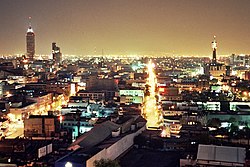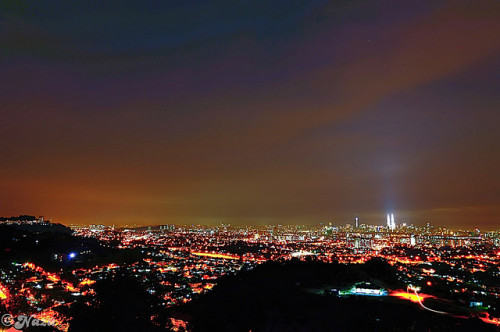There are different types of light pollution?
Yes, as a matter of fact, there are many different types of light pollution. These different types of light pollution include skyglow, light clutter, light trepass, over-illumination, and glare. All types are seen in various places all over the world and are very common.
Skyglow: The illumination of the night sky and parts of it. Much of this light is artificial and can be seen as a glow from miles away. Skyglow is commonly around large cities or towns but can also be around illuminated small things such as, large buildings like malls, etc. Skyglow is usually seen as a dome of light around the town or city giving off the light.
 Light trepass
Light trepass: Light trepass is when unwanted light enters one's property. This can occur from a person using an outdoor light at night which disrupts their neighbor. Some cities in the United States are creating guidelines to reduce light trepass.
 Over-illumination
Over-illumination: The excessive use of light. The unnecessary use of light can be from improper design of lightbulbs, "Daylight lighting"- a method demanded by some citizens to reduce crimes during the day, and indirect lighting techniques.
 Glare
Glare: The negative effect of light that may disrupt or cause problems with vision. Glare can be put into three different catergories.
Blinding glare: Caused from staring directly at the Sun. May cause blindness or permenant problems with vision.
Disability glare: Caused by the blinding from oncoming car lights (high beams), or light scattering in fog or reduced contrast. May caused a reduction in sight capabilities.
Discomfort glare: Usually not dangerous, but may be irritating and cause fatigue.
 Light clutter
Light clutter: Caused by the excessive grouping of lights; usually seen in cities or roads. Light clutter may be distracting and cause accidents due to placement of the lights, as well as aviation hazards because light clutter could cause confusion with runway lights.

 The DarkSky Movement is a campaign to help stop light pollution. Rural areas and areas far from the skyglow of cities have darker skies than cities do. These dark country and rural skies are not pollution by light, which makes more constellations such as the Milky Way and Zodiacal light more visible to the naked eye. The closer you are to a city, the more affected night skies are going to be; the more light that is polluted into night skies, less constellations are visible. The DarkSky Movement's campaign is, in short, trying to make constellations visible more places by reducing light pollution. The DarkSky Movement's website lists areas were dark skies are available and includes a map. There is also a description of sky features to help identify and classify the amount of light polluted in an area at night.
The DarkSky Movement is a campaign to help stop light pollution. Rural areas and areas far from the skyglow of cities have darker skies than cities do. These dark country and rural skies are not pollution by light, which makes more constellations such as the Milky Way and Zodiacal light more visible to the naked eye. The closer you are to a city, the more affected night skies are going to be; the more light that is polluted into night skies, less constellations are visible. The DarkSky Movement's campaign is, in short, trying to make constellations visible more places by reducing light pollution. The DarkSky Movement's website lists areas were dark skies are available and includes a map. There is also a description of sky features to help identify and classify the amount of light polluted in an area at night. 




